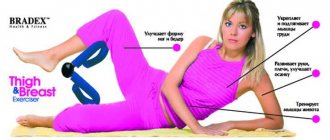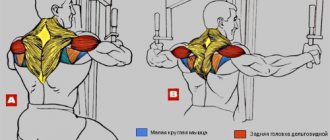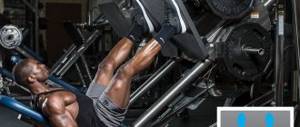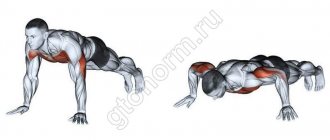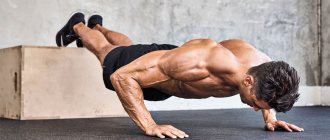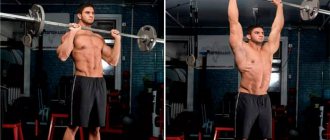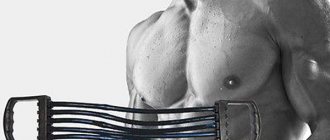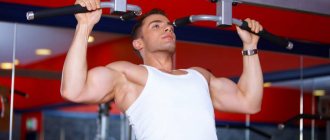Author: Timko Ilya - the ruler of the entire site and fitness trainer | more details >> Rod. 1984 Trained since 1999 Trained since 2007. Author and creator of the site tvoytrener.com. CCM in powerlifting. Champion of Russia and South Russia according to AWPC. Champion of the Krasnodar region according to IPF. 1st category in weightlifting. 2-time winner of the Krasnodar Territory championship in t/a. Author of more than 700 articles on fitness and amateur athletics. Author and co-author of 5 books.
Place in the author rating:
out of competition
(become an author) Date: 2012-05-29 Views: 719,640 Rating: 4.3
| All articles by the author >> | Medals articles >> |
Articles are loading...
| Article medals: | article in TOP 100 | more than 500 thousand views |
Why medals are given to articles:
| Bronze medal: | |
| 1. The article is in the TOP 100 2. The article has more than 3. The article has more than 100 | |
| Silver medal: | |
| 1. The article is in the TOP 50 2. The article has more than 3. The article has more than 500 | |
| Gold medal: | |
| 1. The article is in the TOP 10 2. The article has more than 1 3. The article has more than 1,000 | |
Main muscles - pectoralis major Additional - none (with correct technique) Difficulty of execution - easy
Muscle groups involved in the butterfly exercise
Depending on the type of machine design, various auxiliary muscles may be used during the exercise. However, the main target group is the pectoralis major muscle. The main load during the movement falls directly on it.
It is one of the large muscles of the human body. This muscle group is paired. This means that it consists of 2 symmetrically located parts that perform identical functions.
The main tasks of the pectoralis major muscle are:
- Bringing the raised arm to the midplane of the body.
- Lowering the arm straightened at the elbow joint.
The pectoralis major muscle is also involved in the breathing process. This function is due to the peculiarity of its fastening. The clavicular part originates from the large tuberosities of the humerus. The sternal part is attached to the cartilages of the first 6 ribs and the anterior surface of the sternum. The muscle has a fan-shaped triangular shape.
The pectoral muscles respond with an increase in volume to physical impact quite quickly. This group is prone to venous stagnation of blood during sports activities. Oxygen supply to the thoracic major is carried out using an artery. Therefore, the “pumping” effect is expressed quite clearly even under short loads.
The Butterfly exercise for the pectoral muscles involves the anterior deltoid and serratus muscles.
Also involved in bringing the arm to the middle plane of the body are:
- Pectoralis minor muscles.
- Latissimus dorsi muscles. They engage in work most intensively when working in the simulator with their arms extended forward.
- Trapezoid. It bears the static load of maintaining the correct position of the back while performing the movement.
- Rotator cuff of the shoulder. It is involved when performing the exercise with the upper limbs bent at the elbows. The hands are directed upward, and the shoulder is parallel to the floor.
How to use
For those who decide to take the issue of home training seriously, it would be useful to familiarize yourself with this information. Although the apparatus is not difficult to use, the use of a butterfly simulator is many times more effective when combined with other factors that will provide greater positive results from training. For a certain muscle group, different positions of the simulator are needed, which will be discussed in more detail during the description of the exercises. However, some rules remain the same for sports of any kind.
1. Follow a diet. Of course, it shouldn’t be tough, don’t deny yourself everything. For starters, it would be a good idea to limit your consumption of at least junk food.
2. Do regular workouts. To achieve at least some result, you should never feel sorry for yourself. Exercises have an effect when done regularly. You should try to make time for training no matter what.
3. Having just one type of such equipment, you can perform a full-fledged complex workout and work out all muscle groups.
Why train the pectoral muscles?
Training the chest muscles is determined not only by the goal of increasing their volume, but also by a number of factors related to maintaining human health:
| Correct posture | To give the correct position to the spine, many novice athletes try to do more exercises on the muscles of the back and shoulders. However, the pectoral muscles are their antagonist muscles. Without developed and elastic chest muscles, it is impossible to form a healthy posture. |
| Normalization of respiratory function | The development of chest muscles in combination with breathing exercises and diaphragm training can normalize a person’s respiratory function. This effect is due to the elimination of stoop and an increase in the length of the fibers of the pectoralis major and pectoralis minor muscles, as well as other small auxiliary muscle groups. This helps make the diaphragm work easier. |
| Improved functionality | The pectoral muscles are one of the strongest and largest muscle groups in the human body. Consequently, they are directly or indirectly involved in most everyday tasks. |
| Breast shape improvement | This is especially true for girls. Training the pectoral muscles will not increase the volume of the mammary glands. However, developed muscles are capable of giving an aesthetic shape and lifting the breasts. |
| Strengthening the muscles of the shoulder girdle and back | When performing sports exercises on the chest muscles, a large number of stabilizer muscles and auxiliary muscle groups are involved in the work. This makes it possible to develop the muscles of the upper shoulder girdle harmoniously. |
Indications and contraindications for classes
Reduction of arms in the Butterfly simulator should not be performed with pectoral sprains and tears. It is advisable to refuse to perform this movement if there is pain in the shoulder and elbow joints.
Designed for athletes who set themselves the task of additionally pumping the pectoral muscles with blood. This allows you to increase the number of capillaries in the specified muscle group. This helps to improve the supply of nutrients to the pectoral muscles and also accelerates anabolic processes.
Abs workout
The starting position is lying on your back. Next, you should bend your knees and rest your feet on the floor. Place one handle of the exercise machine between your legs, shoulder-width apart, and hold the other in your hands. In this case, the head of the “butterfly” should look up. The essence of the task is to press your legs to your chest, squeezing the expander. The abdominal muscles must be tense. You can also do this exercise in reverse. Pump up your abs using a butterfly exercise machine, lifting your torso and folding the expander with your hands. In this case, along with the abdominal muscles, the triceps in the arms will be worked out.
Technique for performing exercises on the Butterfly simulator
The Butterfly exercise for the pectoral muscles is performed on a specialized simulator. The exact recommendations for performing the exercise depend on the design of the sports equipment.
The “Butterfly” exercise machine for the pectoral muscles is a vertically oriented frame with blocks and a load. Blocks are needed to transfer force from the athlete’s hands to the weight. The sports equipment is equipped with a bench with a vertical back and a horizontal saddle.
The handles of the simulator can be:
- They are located at a short distance from their axis of rotation and are equipped with soft cushions . To train on this equipment, the athlete's arms must be bent at the elbows. This places additional stress on the rotator cuff and takes pressure off the back muscles.
- Hinged on a long lever . In simulators of this design, the athlete brings his arms together, slightly bent at the elbow joint. This method of performing the movement removes the dynamic load from the deltoid muscles and engages the latissimus dorsi muscles.
Preparing for the exercise
The Butterfly exercise for the pectoral muscles is an isolated movement.
To follow the technique for performing it, it is important to correctly configure the auxiliary equipment:
- Seat height adjustment. It should be set in such a way that the athlete is able to bring his arms in front of the chest, and not above or below the required level.
- Adjusting the backrest angle . Vertical back support should be perpendicular to the floor. It is not allowed to perform the exercise on a machine whose back is tilted even at a slight angle.
- Adjusting the length of the lever of the handles of the exercise machine . If the simulator has this function, then the reach length is selected in such a way that the athlete has the opportunity to press his pelvis and back tightly against the vertical back of the sports equipment bench.
Before starting each workout, you should take time to warm up. As a rule, the butterfly curl is performed in the middle or end of the set, but if the training program begins with this exercise, then before performing it you should thoroughly stretch the muscles of the upper body and warm up the elbow and shoulder joints.
Proper execution
The performance of any sports movement begins with taking the starting position:
- Sit on the exercise bench so that your feet rest firmly on the floor surface. When performing hand raises on the butterfly simulator, the heel should not be lifted off.
- The shoulder blades should be pressed against the vertical back of the machine. During the movement, you should maintain a natural curve in the lumbar spine.
- Take the handles of the exercise machine with a closed free grip. Moreover, depending on the design of the sports equipment, the positions of the hands of the practitioner will differ from each other.
When working with sports equipment whose handles are equipped with pads, special attention should be paid to the position of the elbows. They should be pressed tightly, the forearms are perpendicular, and the shoulders are parallel to the plane of the floor.
Performing exercises for the pectoral muscles in the butterfly simulator
When working with a machine whose handles are movably fixed in the levers, you should also pay attention to the position of your elbows. With the limbs extended forward, the elbows should be slightly bent and slightly raised so that an imaginary straight line can be drawn through the practitioner’s arm.
After the student has assumed the correct starting position, you can begin to perform exercises on the pectoral muscles.
While performing the movement, several recommendations should be followed:
- The handles of the simulator should be brought together until they touch . Bringing the arms to the midline of the body should be done through isometric contraction of the chest muscles. It is not allowed to involve the biceps in the work. To do this, you should control the position of your elbows. During the exercise, your shoulders should be turned. Rounding is not allowed.
- Raising the arms is carried out smoothly, without jerking . Do not lower your arms too far beyond the plane of your body. If the simulator has limiters, then they should be installed at a level of 30-50 mm before crossing the specified plane.
All movements during the exercise must be performed smoothly. For this, a count of 2 or 3 is used. In this case, the athlete performs the positive negative phase of the movement in 2 or 3 seconds. It is necessary to remember the correct breathing technique. Inhalation is carried out while relaxing (extension of the arms), and exhalation is carried out while condensing.
Other butterfly techniques at home
Not all gyms are equipped with a machine for pectoral muscles. It is possible to replace this exercise with other athletic movements.
With dumbbells
The most common method of isolated training of the pectoral muscles is to raise your arms while lying down with dumbbells. The exercise is performed on a horizontal bench or a flat floor. The last option is preferable.
When performing the hands with dumbbells on the floor, there is an insurmountable limitation that prevents the elbows from lowering below the plane of the body. This significantly reduces the risk of injury and makes the athletic movement anatomically correct.
With elastic band
Bringing your arms together with an elastic band can be done either with or without additional support for equipment . In the second case, the elastic band is fixed behind the back of the exerciser at the level of the middle of the shoulder blades. The movement can be performed from a lying, sitting or standing position.
With elastic band
The butterfly exercise for developing the pectoral muscles can be performed using long elastic bands.
In this case, the edges of 2 tapes should be secured to supports located at a distance of 2-3 m from each other. The free ends of the products must be securely fixed in the hands and, taking a few steps forward from the plane of the supports, begin to perform the exercise.
Arm training
To work your triceps, you need to stand straight in place. Place one handle of the butterfly simulator on your thigh, and rest your forearm on the other. In this case, the head of the expander is directed towards you and is at waist level. The essence of the training is to lower your hand all the way and lift it up with the same force. One approach should be approximately 10-15 times.
The butterfly arm exerciser perfectly tones the biceps. A link like this is suitable for this. Stand straight and press one handle of the resistance band towards your lower back. It should kind of wrap around the waist at its angle. If you are applying the machine on the left side, then hold the handle from behind with your right hand and vice versa. With your free hand, squeeze the remaining handle while being between them.
Useful tips
When performing an athletic exercise, you should pay attention to the nuances and details. This will allow you to focus on the target muscle group and avoid common mistakes.
When performing the “Butterfly” exercise, the following recommendations are useful:
- Bringing your arms together in a machine is an auxiliary movement. It should be performed after basic barbell presses.
- Raising your arms takes 1.5-2 times longer than bringing your arms together.
- Jerks and inertia while performing the exercise are not allowed. Movements should be smooth and controlled.
- Raising your shoulders when bringing your arms together should be avoided. This violation of technique shifts the emphasis of the load to the trapezius muscles of the back.
The butterfly curl is an effective exercise for developing chest muscles. It can fit into any basic training program and is an isolated movement.
This determines the number of repetitions performed in each approach. This value should be within 12-15 repetitions. The number of approaches should not exceed 5.
Hips workout
It is believed that the muscles of the inner thigh are the most difficult to train, so we decided to come up with a device that would be suitable specifically for them. Therefore, initially, exercises with a butterfly simulator were designed for the thigh muscles and work best on them. Let's look at a few simple examples.
1. You need to sit on the floor so that there are no objects behind you that you can lean on. Place an expander between your bent knees and squeeze your legs until the machine is completely closed. For beginners, the norm is to perform no more than 20 repetitions. However, it should be based on the individual level of physical fitness. It is important to gradually increase the number of approaches performed to the required norm. This exercise is considered the most effective, and it also trains the abdominal muscles at the same time as the hips. To ease the load, you can perform these manipulations while sitting on a chair, leaning on your back.
2. To target your inner thighs, do a simple exercise. First you need to lie down on the floor. Then place the machine so that the handles are between your knees. In this case, the knee of the raised leg should point to the ceiling. The technique of performing the exercise is to squeeze the handles of the expander, thereby pumping up the thigh muscles from the inside. The number of approaches performed should also depend on the initial degree of physical fitness.
